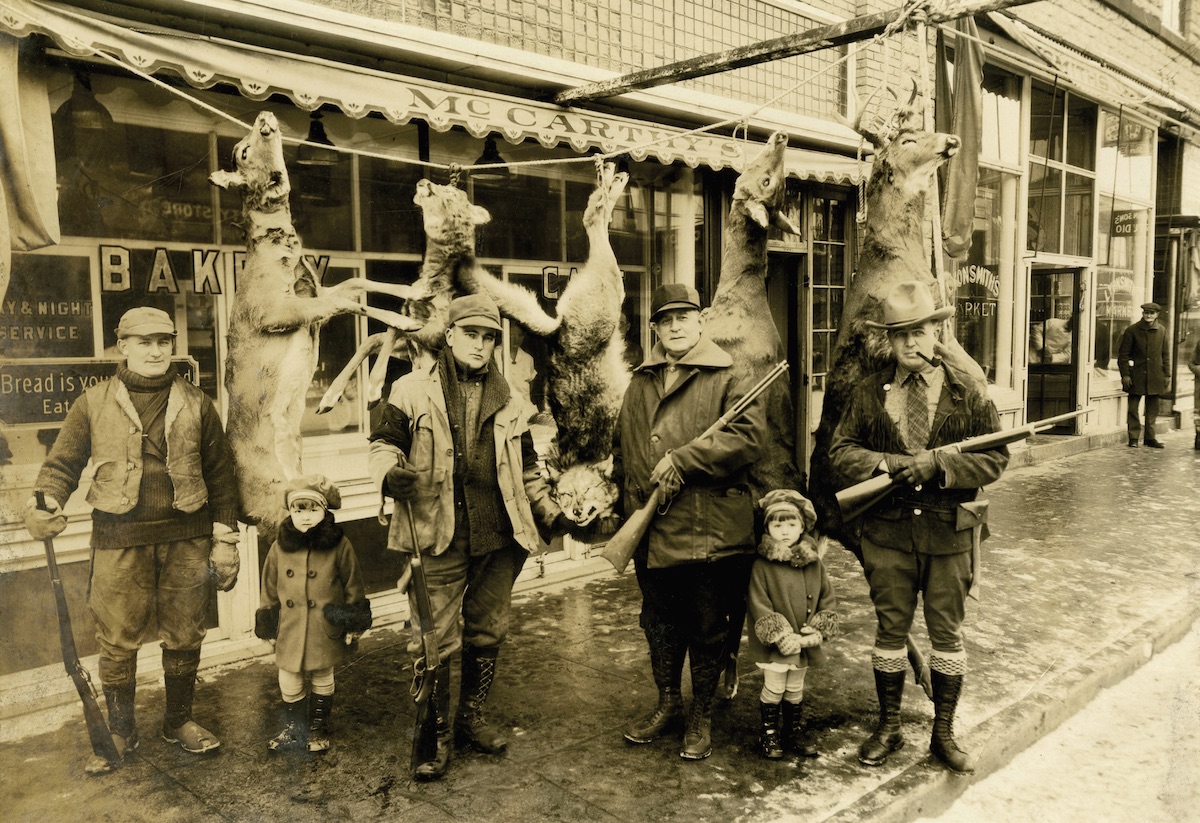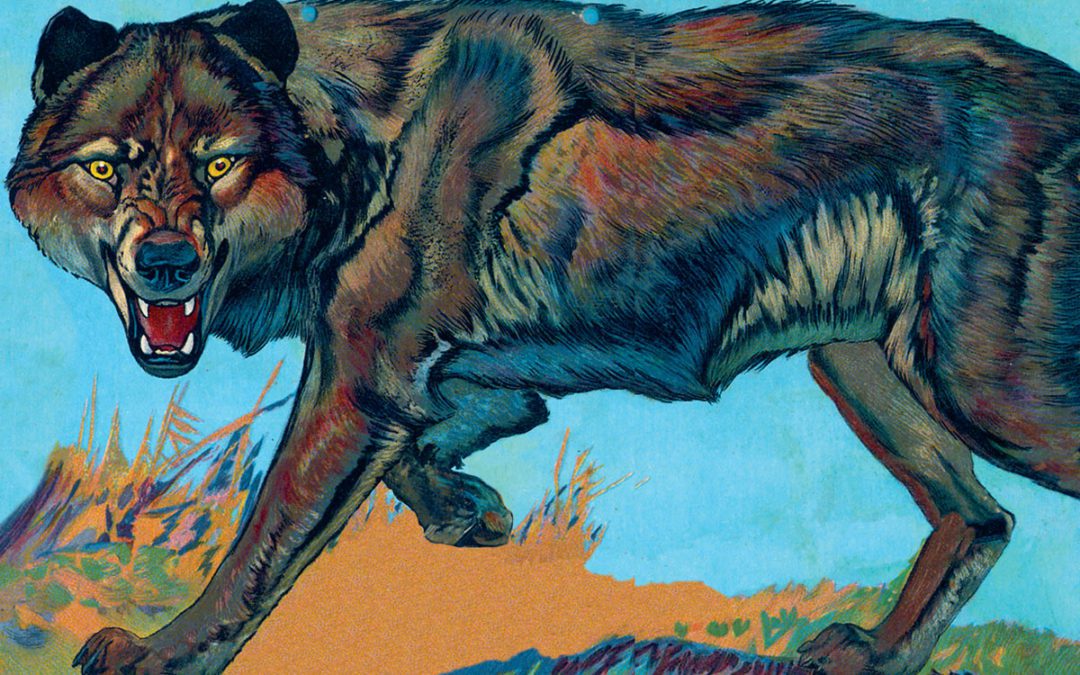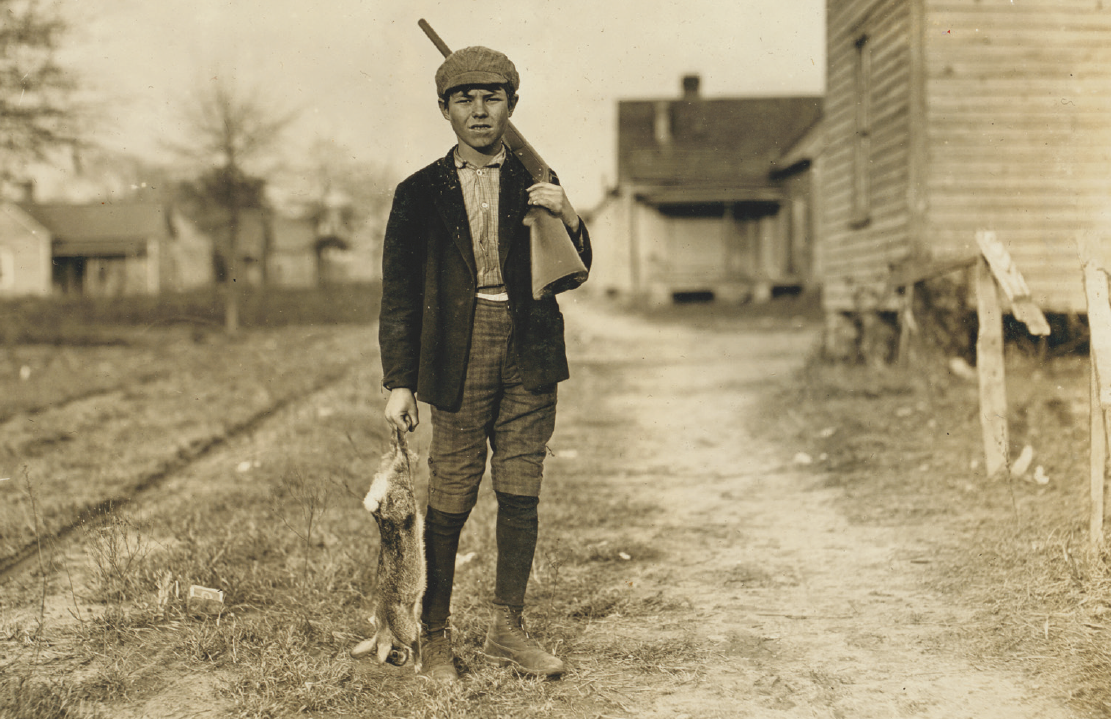For nearly a decade the canny old wolf eluded the best hunters and trappers while waging a reign of terror on farmers and wildlife.
Despite his one serious handicap, he was a streamlined and highly efficient killing machine. It almost seemed as though all the savagery and single-minded determination to slaughter every chicken, turkey, pig, lamb, and cow within a 50-mile radius of the Detroit Lakes region of northern Minnesota was directed at his much-hated and equally determined two-legged adversary.
Narrowly escaping his pursuers by forfeiting his right front paw and part of his leg to jaws of cold steel, the bloodthirsty killer of local legend would come to be known as Old Three Legs. For nearly a decade he invoked fear and terror in both man and beast. It was even reported that he had several threatening encounters with local children.
Around campfires and home hearths alike, stories by hunters and trappers and city dwellers were told about the “spirit wolf” that seemingly could not be stopped by dog pack, bullet or trap. To some, he was the devil incarnate disguised in a wolf skin. In spite of numerous sightings and close calls, he clung to life with a passion and tenacity driven by a keen intelligence and sheer will to survive. He seemed driven to live another day to continue his unprecedented killing spree.
The legend of Old Three Legs originated just over a century ago in the spring of 1916 when a well-known hunter and wolf trapper of local renown, “Dynamite” Bill Foster of Ponsford, Minnesota, reportedly located the den of a lone female wolf. This well-known she-wolf was a marauder and livestock killer in her own right. Having been creased across the spine by a bullet in her younger days and partially crippled in her back legs, she walked with a noticeably strange gait. Some described her labored stride as that of a hyena’s.
Instead of shooting the wolf and collecting the lucrative $6 bounty, Dynamite Bill shrewdly watched the den from a distance, thinking she might have pups. Sure enough, his patience was rewarded when he saw several pups emerge from the den with their impeded old mother. Unexpectedly, however, he watched in horror as the adult wolf proceeded to kill all of the pups except one. It would later be determined that the lone survivor was a male. Perhaps this sage mother knew she could not provide enough milk or sustenance for an entire litter. Whatever the reason, she and her single surviving pup disappeared into the woods, and Dynamite Bill was deprived of the “easy” bounty he hoped to collect.
Over the next year, the she-wolf and her son wreaked havoc on sheep, chickens, turkeys and other livestock in a five-county area around Detroit Lakes. Two years after Dynamite Bill lost his opportunity to collect a bounty, a rural mail carrier named Ole Ystesund found the stiff and weathered carcass of the old female in the woods. Her throat had been savagely ripped open. Those in the know agreed that such a vicious act could only have been committed by her nearly full-grown male pup.
Shortly after the discovery of the mutilated she-wolf, the young male seemed to go on a killing rampage. Like his mother before him, he was never seen with other wolves and likely never took a mate. Instead, he plied his trade for much of his life as a “lone wolf” that killed for the sheer love of killing. The slaughter continued week after week. He seldom ate any of the farm animals he so viciously attacked.
Well-trained dogs, left out at night to protect the livestock, were no match for this shrewd adversary. One evening in northern Otter Tail County, the lone wolf slaughtered 16 ewes belonging to local farmer Elmer Cox. This was not the first time the wolf had violated Cox’s barnyard, but if he had anything to do with it, it would be the last. The enraged farmer vowed revenge.
Cox loaded a horse with traps and other provisions and set out on the killer’s trail, tracking the wolf across five counties in northern Minnesota. His quest became widely known, and he grew to be something of a local folk hero for his courage and tenacity.
One night, while staying at the Lou Tegner farm, Cox learned that fresh sign from the killer had been discovered nearby. He and Tegner immediately devised a plan to end the reign of the killer wolf once and for all. After carefully preparing numerous traps and making sure that all human scent had been painstakingly masked by fresh chicken blood and fish entrails, they tethered a live lamb to a tree on a high knoll in a strategic spot overlooking the barnyard where the wolf would likely stop to survey the scene below. A dozen deadly traps were skillfully hidden under the snow and leaves in a complete ring around the tree. Pleased with their work and believing that no living creature could get through such a hidden barrier of cold steel, they retired for the night.
The next morning, to their utter astonishment, the lamb was dead, torn apart but not eaten. The night’s activities were clearly recorded for the two men to decipher in the displaced snow. The wolf had gone for the bait, as hoped. But this was no ordinary wolf. The crafty animal had carefully tiptoed around each trap toward the lamb, avoiding the circle of death. Then, clutching the doomed lamb in his mouth, he began to retrace his steps by placing each paw precisely in his previous footsteps. His one error in judgment occurred when the rope holding the lamb became taut and apparently threw his body slightly off balance. His left front paw missed the intended paw print and pierced the snow a few inches to one side—directly into the waiting jaws of steel.
The blood and other sign on the ground told Cox and Tegner the enraged wolf had chewed into splinters the heavy stake holding the trap and somehow managed to pull it out of the ground. Carefully avoiding the other traps and leaving the lamb where it lay, the wolf vacated the area with the heavy steel trap still clamped around his lower left paw. The remains of the stake dragged behind.
The determined farmers wasted little time in launching a new plan. The wolf was obviously hindered by the heavy steel trap. With luck, they could catch him and finish the job, if they moved fast enough. They quickly rounded up several neighbors and a pack of experienced wolfhounds and set out on the trail.
For the rest of that day, well into the night and throughout most of the next day, they forged ahead, stopping for brief periods only to rest and eat. The wolf showed no sign of wearing down. At noon on the third day, they decided to release the wolfhounds. Maybe, just maybe, they hoped, the dogs were close enough to the injured wolf to hold him at bay.
That afternoon they found the first of three bloodied and shredded hounds, dead in the snow. The necks of each had been ripped out. That evening the surviving dogs limped into camp.
Around mid-morning the next day, the men made a grisly discovery in the snow. Just ahead lay the heavy trap and stake— with part of the wolf’s left front paw still attached. Having gnawed off his paw, the wolf was now free of his encumbrance.
Tired and somewhat spooked, the men helping Elmer Cox were ready to throw in the towel and go home. Elmer stubbornly forged ahead alone. That same night, tracks in the snow clearly showed that a three-legged wolf had killed a calf belonging to a nearby farmer named John Grammer. From that night on, the killer became known as “Old Three Legs.”
It was brutally cold, the kind of cold that drains a man of his will to continue on. Elmer finally gave up and pointed his horse for home. In the months following, rewards were offered and state authorities were summoned for help. Renowned trappers came from near and far to have a go at Old Three Legs. Officials hired two respected and woods-wise Indian guides, John Red Blanket of Mahnomen and Jesse Mason of Red Lake. Months later, after a “close encounter” with Old Three Legs in which both men emptied their carbines at the beast as it stood only a few yards away, they too gave up and went home, claiming the animal was a “spirit wolf.”
While the two Indian guides were still on the wolf’s track, Old Three Legs raided the Grover Amundson farm and killed 40 sheep and two cows—in a single night!
According to a story written by Ken Prentice, “Mrs. Amundson was a frail, sickly woman, and the neighbors always said the shock of that loss was too much for her. At any rate, she died less than four months later.
“Amundson sent his two small children to relatives in Minneapolis and then he, like many others, got on the trail of Old Three Legs. Weeks and months passed. His face became gaunt and hollow, and his eyes took on a wild staring look. He ignored farmers’ pleas to give up the chase, and eventually he went insane.
“One day, Oscar Nesbitt, a trapper, found Amundson’s body, frozen to death out there on the trail. Nesbitt said that around the body were the tracks of the three-legged destroyer who must have come back to sneer at the poor mortal who had tried so long to destroy him.”
Other reports insisted that Old Three Legs attacked several children. One widely circulated story claimed the wolf confronted the two young children of Ole Ysterund while they were walking home from school one day. The family Airedale bravely stood in the way and sacrificed his life as the children ran to the safety of the house.
Timmy Elliott, the 9-year-old son of farmer Frank Elliot of Hubbard County, had a close call with Old Three Legs when the boy went to the spring to fetch water. The father heard the son screaming, grabbed a rifle and ran toward the spring. The boy later told his father that as he was filling the bucket, he looked up and the wolf was standing only a few feet away. Thinking quickly, the boy lunged into the pool and slipped underwater. Every time he came up for a breath the wolf snapped at his face. When the father showed up, the wolf disappeared.
An old-timer named Julius Skauge was called in to try his hand at Old Three Legs. Widely known for his trapping abilities, Skauge faced months of frustration in which he found many of his steel traps sprung by his intended quarry. Finally, he teamed up with another well-known trapper, John Holton of Lammers, Minnesota, to try a different approach. Holton was famous for his expertise with snares. The two men set snare after snare, all to no avail. Both finally went home in utter defeat.
Time passed. The ruthless killing continued, though age began to creep up on Old Three Legs. Reports began to circulate that whenever his tracks were found, two sets of smaller tracks always accompanied them. This led to much speculation, but the smaller tracks were eventually determined to be those of two coyotes that apparently had taken up with the lone killer. People now swore Old Three Legs had purposely enlisted the help of those two able-bodied hunters to aid him in obtaining food.

Old Three Legs’ eight-year war on sheep, turkeys, chickens and other livestock in northern Minnesota ended abruptly in November 1926 when Fred Darkow shot the legendary wolf while deer hunting with friends. The hunting party included (l-r): Jack Robbins, Darkow, Harry LaDue and George McCarthy. Darkow was known as an accomplished deer hunter and crack shot with his lever-action Winchester. He died in 1987. Photo courtesy of Becker County Museum
By the mid-1920s, Old Three Legs had become the most famous wolf in Minnesota history. Rumors abounded that his strange behavior was caused by rabies or some other brain disorder. Many people believed he was indeed a spirit wolf that was impervious to bullets and could disappear in the blink of an eye. Some insisted his ultimate demise could only come about through a super-human feat.
Then, in November 1926, five deer hunters were camped on the property of Jerry Wettles on Big Medicine Lake in Becker County. As always, they hoped to put in a supply of venison for the cold months ahead. Four of the hunters—Harry LaDue, Fred Darkow, Jack Robbins and George McCarthy—lived in the Detroit Lakes area. The fifth, Herb McArthur, hailed from Ogema. Their method of hunting typically consisted of several daily deer drives.
On the morning of November 20, the men divided up and left camp. Darkow and McCarthy were the designated drivers, while the other three men were to be standers. No sooner had the two drivers gotten started than McCarthy spotted a lone wolf on a hillside about 200 yards away. He fired two quick shots, but the quick-witted animal faded into the brush unscathed.
Startled by the reports, a nearby doe jumped up and ran. The wolf gave chase. Luck, serendipity or something closely akin caused the doe to run right past Darkow. Known to be a skilled hunter and crack shot, Darkow recently had moved to the Detroit Lakes region to try his hand in the fur business raising mink. He was wielding a lever-action Winchester Model 55.
The doe offered a good shot and a chance to collect some winter meat. Darkow made a perfect running shot and watched as she piled up in the snow. Then he caught movement out of the corner of his eye—a wolf. Never taking the gun from his shoulder, he dropped Old Three Legs in his tracks with a well-placed shot to the neck. Fate finally had brought about the demise of one of the shrewdest killers in Minnesota history.
Being a newcomer to the area, Darkow had not been fully aware of the wolf’s widespread reputation. Even though he had killed a number of other wolves, Darkow must have been a little overwhelmed when he was treated like a returning war hero. Having accomplished a feat that dozens of other hunters and trappers had been trying to achieve for nearly nine years, he soon became the most famous hunter in Minnesota. He later collected at least one hefty reward offered by the state.
The carcass of the legendary wolf was hung outside the McCarthy Hotel in downtown Detroit Lakes along with the buck and three does that Darkow’s hunting party had downed. Local residents came from miles around to gawk at the most dreaded wolf in Minnesota history and congratulate its killer. Darkow estimated the wolf to be seven feet long from nose to tail and its weight to be 75 to 80 pounds. By the time several local newspapers ran the story, however, the renegade’s weight had swelled to a whopping 125 pounds.
Old Three Legs was mounted by a Minneapolis taxidermist and put on display in the lobby of the McCarthy Hotel, where it attracted numerous onlookers. Several newspapers across Minnesota wrote stories about the killer’s demise, and in 1931 Field & Stream did a feature on the rogue wolf.
After interest in the mounted wolf subsided at the hotel, Darkow took it home and stored it in a barn on his property where it remained largely forgotten for the next 50 years. The old marauder was eventually donated to the Becker County Museum in Detroit Lakes. After a half-century in obscurity, the fur of the weathered old mount had more than a few “mouse chews.” The museum had the mount restored and placed in a protective glass case. Darkow’s classic Winchester, used to kill Old Three Legs, was eventually donated to the museum and put on display with the mount.
Legends die hard in northern Minnesota. Some still say that when the winter moon is just right and the pines crack in the frigid north wind, you might just happen to catch a glimpse of Old Three Legs running through the snow with that odd, three-legged gait. And if he’s close enough, he’ll turn and look at you with a cold, glassy stare that will make your skin crawl, and then vanish into thin air before your very eyes!
 A superb collection of stories that captures the very soul of hunting. For hunters, listening to the accounts of kindred spirits recalling the drama and action that go with good days afield ranks among life’s most pleasurable activities. Here, then, are some of the best hunting tales ever written, stories that sweep from charging lions in the African bush to mountain goats in the mountain crags of the Rockies; from the gallant bird dogs of the Southern pinelands to the great Western hunts of Theodore Roosevelt. Great American Hunting Stories captures the very soul of hunting. With contributions from: Theodore Roosevelt, Nash Buckingham, Archibald Rutledge, Zane Grey, Lieutenant Townsend Whelen, Harold McCracken, Irvin S. Cobb, Edwin Main Post, Horace Kephart, Francis Parkman ,William T. Hornaday, Sc.D, Rex Beach, and more. Buy Now
A superb collection of stories that captures the very soul of hunting. For hunters, listening to the accounts of kindred spirits recalling the drama and action that go with good days afield ranks among life’s most pleasurable activities. Here, then, are some of the best hunting tales ever written, stories that sweep from charging lions in the African bush to mountain goats in the mountain crags of the Rockies; from the gallant bird dogs of the Southern pinelands to the great Western hunts of Theodore Roosevelt. Great American Hunting Stories captures the very soul of hunting. With contributions from: Theodore Roosevelt, Nash Buckingham, Archibald Rutledge, Zane Grey, Lieutenant Townsend Whelen, Harold McCracken, Irvin S. Cobb, Edwin Main Post, Horace Kephart, Francis Parkman ,William T. Hornaday, Sc.D, Rex Beach, and more. Buy Now



